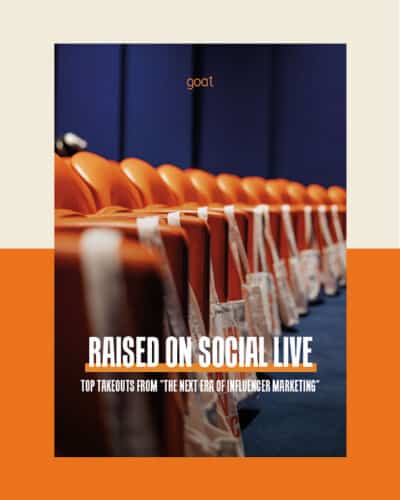We’re putting the ultimate question to the test… Does Size Matter?
Before you panic, we’re obviously talking about macro vs micro influencers, and where brands should invest their budget in 2024.

Two of our US Influencer Experts Lock Horns
As a global social media and influencer marketing agency, we’ve run thousands of influencer campaigns over the years for some of the world’s leading brands. One question we always get asked is… Does Size Matter?
Is it better to go big or go home? Or should brands look to spread their influencer budget across more smaller crestors?
In this virtual event, we tasked two of our influencer experts to debate the issue. Over 45 minutes, they fought their corner for macro vs micro influencers, presented the advantages, disadvantages, and argued for where they think brands should invest their budget.
- Representing Macro… Senior Account Director, Allie Strasser
- Representing Micro… Account Director Gregg Tobin
- And moderating the discussion… Senior Account Director, Max Adagio
Scroll down for the recording of the session, as well as our top 5 takeouts.
Does Size Matter? – Top 5 Takeouts
(1/5) Operationally, what are the considerations for a macro vs micro influencer campaign?
More isn’t always better. That was the opening argument from our Macro-backer, Allie. More creators means more approval, reviewing and contracting of content. Although micro creators are smaller in sizing, this doesn’t alleviate contractual constraints either. “Perhaps the most important consideration that we skip over is the fact that smaller creators aren’t always dedicated to being a creator.” So what you’re left with is a limited schedule where you can collect content, as the creator has other commitments.
But the same can be said for macro creators, insisted Gregg. Liaising with high profile creators, where there is more money, legal scrutiny, and eyeballs directed at them presents its own set of challenges. “Larger creators are protective over what their audiences see, so brands looking to partner with larger creators might find less creative control over their content.” In that respect, macro creators have the lionshare of leverage.
(2/5) How do we evaluate the success of macro vs micro
Micro creators are all about engagement and tuning into their finer audience. So to determine the success of a micro influencer, you’re really looking at engagement rate and mid-funnel actions like post saves and shares that can determine audience intent toward a product.
On the macro front, it’s all about reach. They have such diverse audiences, which is why brands spotlight them in the first place. These influencers have the capability to reach potential consumers on a national, and even global scale. This raises the question of seeing content go viral. We see influencer content driving sellouts on commerce sites like Amazon which is a testament to how powerful their reach is. One of the main arguments for macro creators here, is their ability to seamlessly weave brand messaging into their content, and target their audience in a more authentic way, because after all, audiences don’t like being sold to.
(3/5) Additional investment for paid gives micro a creative edge
Infleuncer-led paid media is having its big boom. Gregg makes an interesting point on the creative edge that micro influencers give in terms of allowing for more investment on the paid media front. “Having that additional creative makes it easier to measure against all the different micro creators enlisted in a campaign.”
Pointing to a current Goat campaign in the US, where paid campaigns had a ROAS of over $3. Out of the 5 best performing influencer creatives, four were from micro influencers, and two have followings of less than 50,000. “Facebook is called the book of faces for a reason. They want to see content from people, not brands.” Brands don’t always need to enlist celebrities, what matters is that they’re talking about things they’re interested in. So from the paid perspective, it’s a lot easier to measure a campaign from this angle than it is with organic. And micro creators means more budget is available for paid media.
(4/5) Who comes out on top in the authenticity argument
From the get go, you’d typically think that micro creators take the crown in the way of authenticity. They’re more relatable, down to earth, and a lot closer to everyday social users than macro.
Fighting the corner for macro, Allie had a different take.
“It’s common for micro creators to promote multiple products on their pages, to the point where 90% of their content consists of ads. There’s no consistency between endorsements and their content is too ad heavy.” Allie argued that larger creators are more selective of the brands they work with, and are more creative in how they incorporate brand messaging, so it doesn’t feel like their audience is being sold to. Bigger creators aren’t going to promote something that isn’t authentic to them or their brand. “We’ve had creators turn us down for specific products simply because it doesn’t resonate with them.”
(5/5) Ryan Reynolds and ad fatigue
Everyone loves Ryan Reynolds… But, what has this got to do with the debate?
Like a lot of macro and hero creators, we love him for his personality. People ultimately want to laugh, they want to have fun. What they don’t want is to feel like they’re being sold to. Ryan, along with many more macro and hero influencers, is great at getting a message across that doesn’t make their audience feel as though they’re being served an ad. Allie believes this is where larger creators have mastered the art of influencer marketing. “These creators take on projects and endorse products because it’s something they feel strongly about.” Allie’s message to brands is to let influencers influence. Let them do what they do best.
As Gregg put it, niche content to niche audiences. “Say you’re following a Dogecoin evangelist, who only has around 60K followers. Everyone follows that person because they’re interested in Dogecoin.” Ryan Reynolds has a tonne of followers because he’s an actor, he owns Wrexham FC, he’s married to Blake Lively, and so on. “Our Dogecoin enthusiast can speak specifically to his audience about their interests, because that’s why they’re following him.” So for micro this means the conversion rate and ROI you’re going to get is much stronger than a “Ryan Reynolds.”
So, you have a $100K influencer budget… How is it being spent?
On the micro front, Gregg starts with 40% of his budget going towards acquiring influencers, and 60% going towards paid. This will ensure that there is enough creative, room to test and learn, and the capacity to boost creators who have strong dedicated followings. “The beauty of distributing the budget means we can run a full funnel campaign, optimized for video views with prospective audiences, and then conversions for bottom of funnel audiences.” With micro… less is more!
Allie’s counter argument was a 20/80 split, with the largest part of the budget going toward organic content. “When you invest more in organic, you have the potential to get more content. Although larger creators can be more expensive, focusing on organic means you can get more content, more creators, and you’ll still have a budget left over to boost through paid.” With this split, Allie planned to stack a good amount towards paid media, run tests, and potentially get content that spans different social platforms, too.
…
So, who won the debate?
We think both of our Goat influencer experts did an excellent job, and from our side, what’s clear is that both macro and micro influencers are incredibly powerful. Brands just need to determine exactly what it is they’re hoping to achieve from their campaign.
Watch the full debate below and see if you agree!





